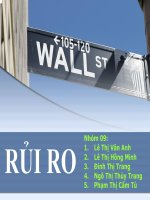Thuyết trình tài chính doanh nghiệp THE STOCK MARKET AND CORPORATE Investment A Test of Catering Theory
Bạn đang xem bản rút gọn của tài liệu. Xem và tải ngay bản đầy đủ của tài liệu tại đây (1.32 MB, 52 trang )
Company
LOGO
Paper 4:
Paper 4:
THE STOCK MARKET AND
THE STOCK MARKET AND
CORPORATE
CORPORATE
Investment: A Test of Catering Theory
Investment: A Test of Catering Theory
(Author: Christopher Polk)
1. Phạm Thị Ngọc Yến
2. Từ Thị Thùy Trang
3. Võ Trọng Hiếu
4. Lê Thanh Nam
5. Nguyễn Xuân Thùy
Nhóm 1:
GVHD: GS.TS Trần Ngọc Thơ
CONTENTS
1. Introduction
2. Mispricing and Invest
3. Empirical Analysis
4. Conclusions
Introduction
Introduction
In this paper:
In this paper:
Result
•
Test a catering theory that describing how stock market
mispricing might influence individual firms’ investment
decisions.
•
Use discretionary accruals as our proxy for mispricing.
•
There is a positive relation between abnormal investment and
discretionary accruals;
•
Abnormal investment is more sensitive to discretionary
accruals with higher R&D intensity firms or share turnover
(firms with shorter shareholder horizons);
•
Firms with high abnormal investment subsequently have low
stock returns; and that the larger the relative price premium,
the stronger the abnormal return predictability.
A firm that uses capital K (at time 0). K is continuous and
homogenous with price c.
The true value of the firm at time t is V(K).
The market value of firm at time t is:
Vmkt (K) = (1 + α
t
)V(K),
=> α
t
measures the extent to which the firm is mispriced.
Firm misvaluation depends on this level of mispricing α,
=> It will disappears over time at the rate p, (αt = αe
−pt
).
1. Investment Decisions and Mispricing
Assume that shareholders may have short horizons. Each
shareholder j will need liquidity at some point in time, t + u,
where the arrival of this liquidity need follows a Poisson
process with mean arrival rate qj [0,∞). ∈
A small qj suggests that the particular shareholder is a long-
term shareholder who intends to sell the stock many years
after the initial investment. A short-term investor has a
large qj. We define shareholder j ’s expected utility at time
0 as
1.Investment Decisions and Mispricing
The shareholder’s expected level of income is a weighted
average of the share price before and after the true value
of the company is revealed. For simplicity, in Equation (1)
we normalize the number of shares to one.
The expected level of the shareholder’s income depends
on how likely the shareholder is to receive a liquidity
shock before the stock price reflects the true value of the
company.
1. Investment Decisions and Mispricing
q is the arrival rate of the average shareholder.
The larger q is (the more impatient investors are, on
average), the higher the weight on the informationally
inefficient share price.
The larger p is (a firm with shorter maturity projects), the
higher the weight on the share price under symmetric
information. The FOC of the manager’s problem3 is as
follows:
1. Investment Decisions and Mispricing
The optimal investment level is K ; when there is no ∗
mispricing (α = 0), V(K ) = c. ∗
When the firm is overpriced (α > 0), the manager invests
more than K . ∗
Even if the marginal value from the investment is lower
than the cost of investing, the market’s tendency to
overvalue the investment project may more than
compensate for the loss from the value destroying
investment.
1. Investment Decisions and Mispricing
The overinvest increases as the expected duration of
mispricing increases (p becomes smaller) and decreases as
the horizon of the average shareholder lengthens (q
becomes larger).=> if managers expect the current
overvaluation to last, and if investors have short horizons,
then managers increase investment to take advantage of
the mispricing.
The underinvestment occurs when firms are underpriced.
If the market is negative about the value of the firm (α <0),
the manager will invest too little. => The level of
investment will be lower as the expected duration of
mispricing increases and/or the horizon of the average
shareholder shortens.
1. Investment Decisions and Mispricing
2. Empirical Analysis
2. Empirical Analysis
Data
Data
•
Data come from the merged CRSP–Compustat database and
Zacks, which is available to us through Wharton Research
Data Services. Our sample comprises firms over the period
1963–2000.
•
We do not include firms with negative accounting numbers
for book assets, capital, or investment.
•
When explaining investment, we study only firms with a
December fiscal year-end
•
We drop firms with sales less than $10 million, and extreme
observations
Empirical Analysis
Empirical Analysis
2.2Discretionary accruals and investment
2.2Discretionary accruals and investment
In all our analyses, we estimate linear models of firm investment.
Our specification regresses firm investment on discretionary
accruals (our proxy for mispricing), a proxy for Tobin’s Q , and
firm cash flow, controlling for firm- ( fi ) and year- ( γt ) fixed
effects,
Empirical Analysis
Empirical Analysis
www.themegallery.com
Empirical Analysis
Empirical Analysis
We define discretionary accruals, DACCR
i ,t
, as the
difference between realized accruals and normal
accruals as forecast by Chan et al’s. (2001) model.
In this model, normal accruals are computed as a
constant proportion of firm sales estimated using
the last five years.
Tobin’s Q , Q
i ,t −1
, is defined as the market value of
assets divided by the book value of assets, A
i ,t −1
(Compustat I tem 6)
www.themegallery.com
Company Logo
Empirical Analysis
Empirical Analysis
The one-year expected profitability, E
t −1
[EARN
i,t
] /A
i
,t −1
, is the median analyst year t − 1 forecast of
earnings in year t divided by the book value of
assets in year t − 1.
R & D
i ,t −1
/A
i ,t −1
measures R&D intensity (R&D
expense (Compustat I tem 46) over the book
value of assets).
Share turnover, TURN
i,t −1
is the average, in
December t −1 , of the daily ratio of shares traded
to shares outstanding at the end of the day. BE
/ME
i ,t
is firm book-to-market equity.
ME
i ,t
is firm book-to-market equity. MOM
i ,t
is firm
stock-return momentum.
www.themegallery.com
Empirical Analysis
Empirical Analysis
•
The dependent variable is individual firms’ investment
capital ratios (I
i ,t
/K
i ,t −1
), where investment, I
i ,t
, is capital
expenditure and capital, K
i ,t −1
, i s beginning-of-year net
property, plant, and equipment. Tobin’s Q , Q
i ,t −1
, i s
beginning-of-period market-to-book.
•
CF
i ,t −1
/K
i ,t −2
equals the sum of earnings before
extraordinary items and depreciation over beginning-of-year
capital.
•
Our analysis critically depends on identifying situations
where firms are mis-priced ( α )
Empirical Analysis
Empirical Analysis
•
Thus, any evidence linking investment to mis-pricing can
never be conclusive as that mispricing can also be
interpreted as compensation for exposure to risk.
Therefore, although we use discretionary accruals, a
variable that is difficult to link to risk
•
Our proxy for mispricing exploits firms’ use of accrual
accounting. Accruals represent the difference between a
firm’s accounting earnings and its underlying cash flow.
For example, large positive accruals indicate that earnings
are much higher than the cash flow generated by the firm.
Several papers show a strong correlation between
discretionary accruals and subsequent stock returns,
suggesting that firms with high discretionary
accruals are overpriced relative to otherwise similar
firms.
For example, Sloan (1996) finds that those firms
with relatively high (low) levels of abnormal accruals
experience negative (positive) future abnormal stock
returns concentrated around
future earning announcements.
Teoh, Welch, and Wong (1998a,b) find that IPO
and SEO firms who have the highest discretionary
accruals have the lowest abnormal returns post
equity issue.
www.themegallery.com
More recently, Chan et al. (2001) investigate
the relation between discretionary accruals and
stock returns. Confirming previous results, they
also find that firms with high (low) discretionary
accruals do poorly (well) over the subsequent year.
Most of the abnormal performance is concentrated
in the firms with very high discretionary accruals.
These results are puzzling because, in principle, if investors can detect earnings
manipulation,higher accruals should not affect the stock price. Howev r, a large body of
evidence indicates that investors seem to simply focus on earnings (see Hand, 1990;
and Maines and Hand, 1996).
We use past evidence on the correlation between
discretionary accruals and stock returns to justify
the use of discretionary accruals as our mispricing
proxy.
www.themegallery.com
We measure accruals (ACCR
i ,t
) by
Where ΔNCCA is the change in noncash current
assets, ΔCL is the change in current liabilities minus
the change in debt included in current liabilities and
minus the change in income taxes payable, and
DEP is depreciation and amortization.
www.themegallery.com
The differences between earnings and cash flow
arise because of accounting conventions as to when,
and to what extent, firms recognize revenues and
costs. Within those conventions, managers have
discretion over accruals adjustments and may use
them to manage earnings. For example, a manager
can modify accruals by delaying recognition of
expenses after advancing cash to suppliers, by
advancing recognition of revenues with credit sales,
by decelerating depreciation, or by assuming a low
provision for bad debt.
www.themegallery.com
To capture the discretionary component of
discretionary accruals, we follow Chan et al.( 2001)
such that
DACCR
i, t
= ACCR
i, t
- NORMALACCR
i, t
(5)
www.themegallery.com
Company Logo
where we scale accruals by total assets and model
NORMALACCR
i ,t
as a constant proportion of firm sales. In
other words, to capture the discretionary component of
accruals, we assume that the necessary accruals
adjustments are firm-specific.
7
For example, asset-
intensive firms typically have relatively high depreciation.
In Table 2, Panel A, column (1) displays the
results of regression (3). When we control for
investment opportunities and cash flow, we find
that firms with high discretionary accruals invest
more.
The coefficient of investment on discretionary
accruals measures 0.201 with an associated
t-statistic of 8.78
Firms with abnormally soft earnings invest more
than the standard model would indicate.
www.themegallery.com
Company Logo
This effect is economically important. A one-
standard-deviation change in a typical firm’s level
of discretionary accruals is associated with
roughly a 2% change in that firm’s investment as
a percentage of capital, which corresponds to 7%
of the sample mean. Our results are consistent
with a recent paper by Bergstresser, Desai, and
Rauh (2004) that shows that a specific type of
earnings manipulation based on the assumed rate
of return on pension assets for companies with
defined benefit pension plans is correlated with
investment decisions.
www.themegallery.com
Company Logo
Note that Abel and Blanchard ( 1986) suggest
that mispricing may smear the information in Q
concerning investment opportunities. This
possibility actually works against us finding any
independent effect of discretionary accruals. If Q
is correlated with mispricing, then the coefficient
of discretionary accruals underestimates the
effect of mispricing on investment.
www.themegallery.com
Company Logo









